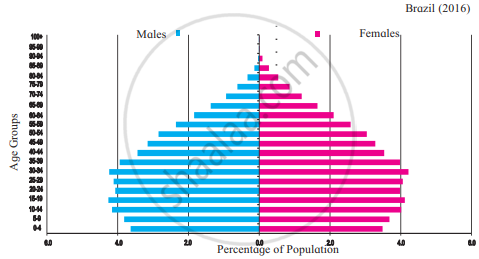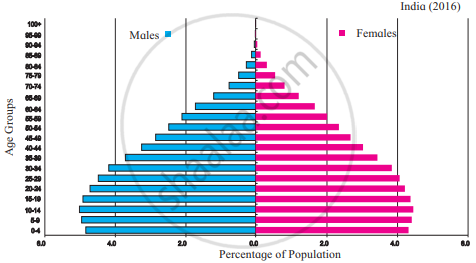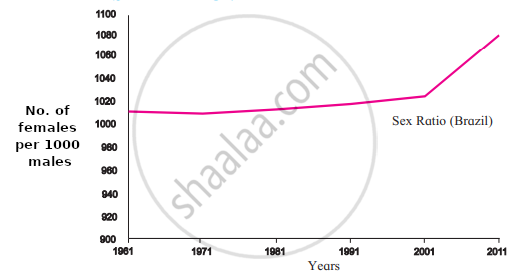Advertisements
Advertisements
Question
Observe the following graph and answer the questions given below-
India- % of population (2016)

- Which type of graph is this?
- Which age group has the highest population?
- Write class interval of age groups given on Y-axis.
- Whose number is more in males and females of age above 60?
- How much percent of females are found in age group of 55 to 59 years?
- After which age group is the decrease in population found?
Solution
- This is the population pyramid, which shows age and sex of population.
- The age group of 10 to 14 years has the highest population.
- The class interval of age groups given on ‘Y’ axis is 5 years.
- In the age group of above 60 years, the percentage of the male and female population is almost the same.
- In the age group of 55 to 59, 2% females are found.
- The decrease in population is found after the age group of 15 to 19.
RELATED QUESTIONS
With the help of given statistical data prepare a simple bar graph and answer the following questions:
India – Trend of Urbanisation (1961-2011)
| Year | Percentage of Urban Population |
| 1961 | 18.0 |
| 1971 | 18.2 |
| 1981 | 23.3 |
| 1991 | 25.7 |
| 2001 | 27.8 |
| 2011 | 31.2 |
(1) What is the interval of the data?
(2) Which decade shows slow rate of urbanisation?
(3) Which decade shows high rate of urbanisation?
Observe the following graphs and answer the questions given below them:


(1) What do the above graphs show?
(2) Which country has highest male population?
(3) Which country has highest female population?
(4) Which country has rapid increase in female population after 2001?

(5) What was the female population in India in 1961?
(6) Which country has more than 1000 female population?
Is the following sentence right or wrong? Correct the wrong one.
The life expectancy of Indians is decreasing.
Classify the factors affecting the distribution of population into favourable and unfavourable. Nearness to sea, lack of roads, temperate climate, lack of industries, new cities and towns, tropical moist forests, minerals, semi-arid climate, cultivable land.
- Compare and classify the population densities shown in the squares ‘a’ and
‘b’ representing 1 sq.km of area. - If in figure B, one sign = 100, then what will be the sex ratio?
(a)
(b)
What could be the reasons of lower sex ratio in any region?
Expectancy of life is still less in developing countries.
Observe the following graphs and answer the questions given below:


- In which country is the number of female is more in the age group 15-19 years?
- In which country do you find a higher percentage of the population belonging to the age group 80 + years?
- In which country is the number of children of age group 0-4 years more?
- In Brazil, which age group has the highest population.?
- While comparing the age-sex pyramids, which pyramid has a broader base?
- In which country is the proportion of the population belonging to the age group less than 15 years lesser?
Observe the following graph and answer the questions given below:


- What does the sex ratio of India indicate ?
- Since when has the sex ratio in India increased?
- What was the condition of sex ratio in India in 1961-71?
- What does sex ratio mean?
- What does the sex ratio of Brazil indicate?
- In which year did the women outnumber men in considerable amount in Brazil?
Is there a relationship between increase in life expectancy and growth of population? If yes, how?
